#Quantum Computing
Text
The potential of quantum computing is immense, but the distances over which entangled particles can reliably carry information remains a massive hurdle. The tiniest of disturbances can make a scrambled mess of their relationship.
To circumvent the problem, quantum computing researchers have found ways to stabilize long lengths of optical fibers or used satellites to preserve signals through the near-vacuum of space.
Continue Reading.
93 notes
·
View notes
Text
Hey, so--we cooled your boyfriend down to a hundredth of a kelvin above absolute zero. Yeah, it was so cold that all of the chemical reactions in his body ceased. Sorry. We, uh, yeah, we used him as a dielectric material in a tiny qubit. And then we quantum-entangled him with another qubit, just to see if we could. Sorry. Yeah, anyway, we thawed him out after two weeks and apparently he's doing fine now. Didn't really teach us anything about how quantum processes work in biological systems, but it sure was, uh, cool. If you'll pardon the pun.
854 notes
·
View notes
Text
I looove that quantum computers look, you know, LIKE THAT ™




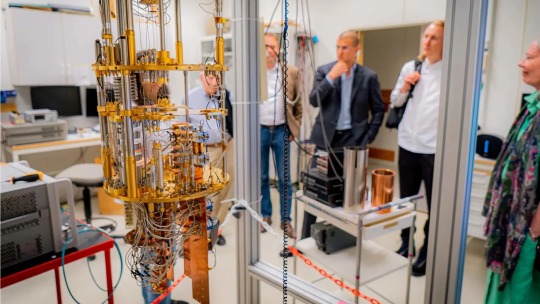




Like a clockwork waiting to chime in a new age (or a bell who may toll for all of us).
Next step is pentagrams and runes instead of circuits.

How many angels can dance on top of a qubit chip? Immeasurable
386 notes
·
View notes
Text

Quantum computing
#wafer#semiconductor#silicon wafer#quantum computing#quantum computer#wikipedia#wikipedia pictures#tech#technology#techcore#technologycore#computing#computer engineering#science
148 notes
·
View notes
Text
Just learned about superdense coding and that shit is SO COOL. Two for the price of one… quantum style 😎
59 notes
·
View notes
Text
Why should you care about quantum computers?
Post #5 on Physics and Astronomy, 23/09/23
Welcome back. It’s been a while.
First, let’s backtrack. What even are quantum computers?
Today’s computers are run on bits. These are the smallest increment of data on a computer, and are run in binary–they can be in the state of either 0 or 1. This essentially corresponds to two values: off and on.
This, therefore, means that information can only remain in one, definite state.
So, what makes quantum computers so different?
A quantum computer is run on qubits (short for quantum bits). Qubits, instead of a single state, can remain in an arbitrary superposition of states (meaning it’s not in any specific state until it’s measured). Qubits, on their own, aren’t particularly useful. But it performs one, very useful, function: it can store a combination of all possible states of the qubit into one area. This means that complex problems can be represented differently in qubits compared to bits.
Quantum computers aren’t fully developed and at their full capacity quite yet. So far, there’s nothing a quantum computer can do that a regular supercomputer cannot. However, this opens an opportunity for some wonderful new things to happen.
One of these things can include the cracking of passwords.
Today’s encryption works by using “trapdoor” functions, which means that data is easy to compute in the forward direction, but extremely difficult to crack in the reverse without special keys. Keywords, ‘extremely difficult’; it is not impossible. However, this is not a massive concern: encryption works on the basis that it would simply take too long to crack.
To give you a tangible example, 100,003 and 131,071 are relatively easy to multiply together, giving you the answer 13,107,493,213. How easy, however, would it be to determine a prime factor pair of this number? It would take a computer a long time to figure this out, since it runs on bits, which can only show one definite state of data.
With quantum computers, it’s different. As aforementioned, qubits can remain in a superposition of states; somewhere in there, the desired answer lies. It’s just a matter of obtaining the resources to make this happen.
Don’t worry, though. Ordinary people aren’t at any risk quite yet.
#physics#astronomy#studyblr#astrophysics#stem#sixth form#mathematics#quantum physics#quantum computing#engineering#encryption#alevels
78 notes
·
View notes
Text
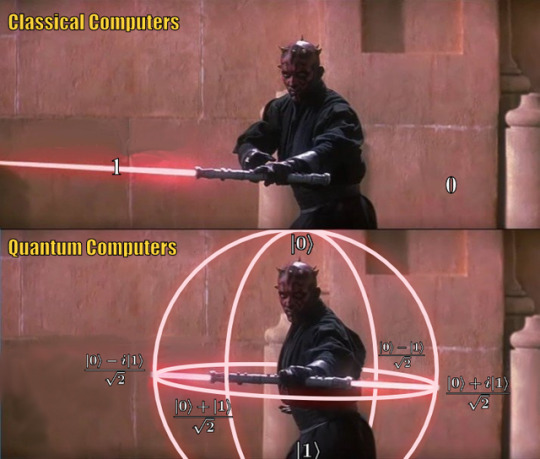
#hm yesyes i know what's going on#meme#nerdy memes#memes#nerd humour#nerdy meme#physics#quantum physics#physics meme#quantum computing
44 notes
·
View notes
Text
Spent quantum computing lecture doodling Batman characters in pure confusion.
Behold, the fruits of my labors!

Here we have Oracle, Robin V, Red Hood, Nightwing, Robin IV, and a sleeping Robin III, accompanied by something about representing complex numbers with e, phase shifts, and single-qubit gates.

Now we��re onto two-qubit gates, something about superposition, and now we have a universal gate set (which the instructor was literally grinning and laughing about). Plus Tim waking up “early” (11:46 am) and a tiny Robin hiding in Batman’s cape.
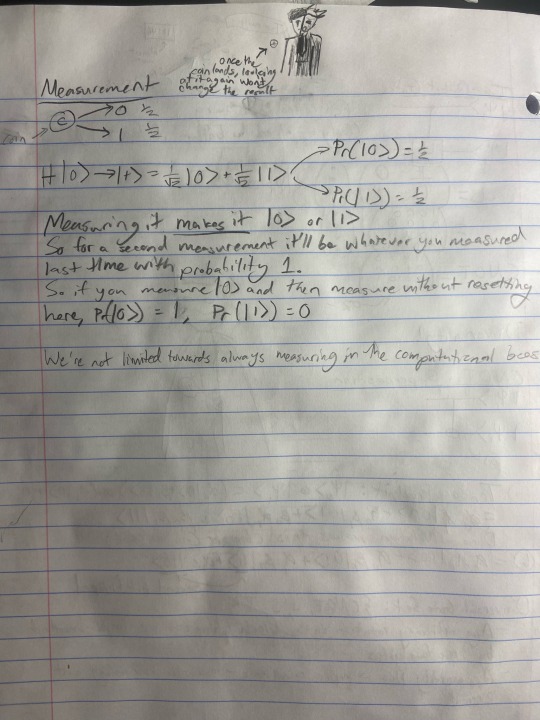
Notes about measurement collapsing the quantum state. A coin flip was mentioned, so there’s an obligatory Two-Face doodle and metaphor.
#batman#doodle#doodles#fanart#idk if this really qualifies but it’s the closest I get#dick grayson#bruce wayne#jason todd#tim drake#damian wayne#barbara gordon#stephanie brown#two face#dcu#dc comics#batfamily#batfam#quantum computing#quantum physics#computer science
33 notes
·
View notes
Text
How to Make - Operate -- Quantum Computers Pt 1
Futuristic Quantum Computing with instructions!



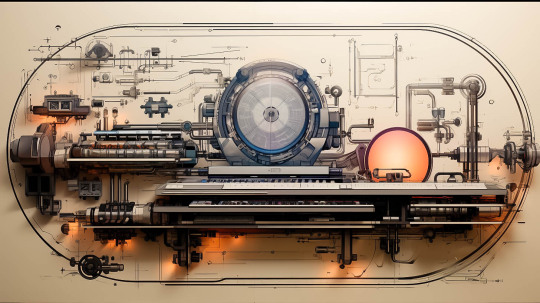





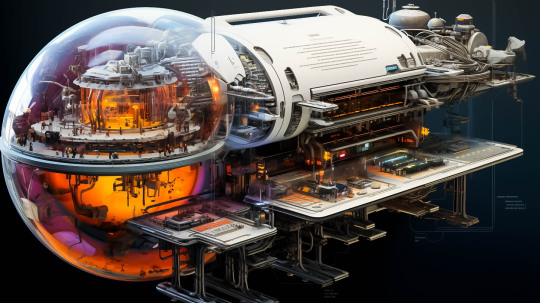
#quantum computing#schematics#blueprints#aiartwork#midjourney#diagrams#diagram#yan61#YAN61#image prompt#computer design#ultimate computer#ai artwork#generative art#futurism#space computer
62 notes
·
View notes
Text
The electron is the basic unit of electricity, as it carries a single negative charge. This is what we're taught in high school physics, and it is overwhelmingly the case in most materials in nature.
But in very special states of matter, electrons can splinter into fractions of their whole. This phenomenon, known as "fractional charge," is exceedingly rare, and if it can be corralled and controlled, the exotic electronic state could help to build resilient, fault-tolerant quantum computers.
To date, this effect, known to physicists as the "fractional quantum Hall effect," has been observed a handful of times, and mostly under very high, carefully maintained magnetic fields. Only recently have scientists seen the effect in a material that did not require such powerful magnetic manipulation.
Read more.
17 notes
·
View notes
Text
How to Use Quantum Computing as a Tool for Philosophy of Science
Recently, I attended the MCQST 2023 Conference on which Lídia del Rio presented the research with her collaborators about quantum thought experiments in a quantum computer. They wrote a whole package to do this and describe the ideas in detail in [1]. It's definitely worth checking out the paper and the package - to make you curious let us look at an illustrative example [1, p.4-10].
Example Setting

Let us consider the following setting (as depicted in the image above): Alice has some two-level quantum system R (e.g. a qubit) in the state written in blue. Thus, the probability of obtaining a=0 in a measurement is 1/3 while the result a=1 will be obtained with a probability 2/3. Depending on the outcome, Bob receives the a system in state |0> (if Alice's result was a=0) or in state |+> ~ |0>+|1> (if Alice's result was a=1). In turn, Bob measures his system in the computational basis and can receive the outcome b=0 or b=1. What conclusions can Bob draw about Alice's measurement outcomes based on his? It is assumed that Bob knows the rules upon which Alice sends him the different systems. Thus, if his outcome is b=0 he cannot make any retrodiction since the outcome b=0 could stem from both possible states |0> and |+>. However, if he measures b=1 he knows that his state must have been in |+> and thus he can retrodict that Alice's outcome must have been a=1. Therefore, in one of both cases Bob can draw a deterministic conclusion about Alice's outcome.
So far so good, at this point I'd like to mention that even though this setup seems to be motivated by the Frauchiger-Renner Thought Experiment, we will not talk about apparent paradoxes or fundamental questions in foundations of quantum mechanics themselves. Instead the setting is supposed to be easy to grasp and can therefore neatly serve the purpose to illustrate how a thought experiment can be formalized in terms of quantum circuits. Hence, we will discuss a tool which can be used for quantum thought experiments in general by using a simple example.
Alice's and Bob's Brains in a Quantum Circuit

Next, we will translate this specific setting as a quantum circuit - by going through the above illustration of the resulting circuit. The first qubit is initialized in the state of Alice's system R. Even though this seems to be the only true quantum system at hand, we will act as if there was an external observer who looks at both Alice and Bob and their respective systems. Imagine you are in the position of this external observer and set the Heisenberg cut at this point: You are classical while both Alice and Bob are quantum (as it is done in Neo-Copenhagen interpretations). Then, one also has to model the "brains"/"memory" of both Alice and Bob. We start with Alice first: we assign a wire of the circuit to Alice's reasoning which basically means that somehow the possible measurement results are stored in this respective qubit. The wire representing her memory is initialized in state |0> and is connected to her system R via a CNOT gate. This means that if the system R was in state |0>, the qubit representing Alices would stay in |0>. However, if R was in |1>, Alice's state of memory would be in |1> as well. This way, one can model different measurement outcomes and also Alice's memory in a unitary manner without explicitly including measurements in the circuits yet. This is necessary since from our external perspective everything about Bob and Alice is considered to be quantum, i.e. must be modelled unitarily. Now, we can look at the third wire: It is again initialized in state |0> and remains in this state if Alice's memory is in state |0>. However, the controlled Hadamard will act on the third wire if Alice's memory is in state |1>, hence it would be turned into state |+>. Thus the controlled Hadamard models the system S which Bob receives - conditioned on Alice's measurement outcome of R. Finally, the last wire is again initialized in |0> and is supposed to model Bob's memory. Exactly as Alice's memory, also the relation between Bob's memory and his system S is modeled via a CNOT gate.
As a result we now have a quantum circuit which represents the setup from above from an external perspective. I think already at this point one can see the beauty of this approach - while one needs quite a lot of sentences to explain the simple setup, it can very easily be grasped by the neat quantum circuit. What is left to do now is to model Bob's reasoning regarding his retrodiction on Alice's outcome. We found that Bob can draw a deterministic conclusion about Alice's measurement outcome if his outcome is b=1, in the other case he cannot draw such a conclusion. How can this be mapped into a quantum circuit?
Modelling Bob's reasoning
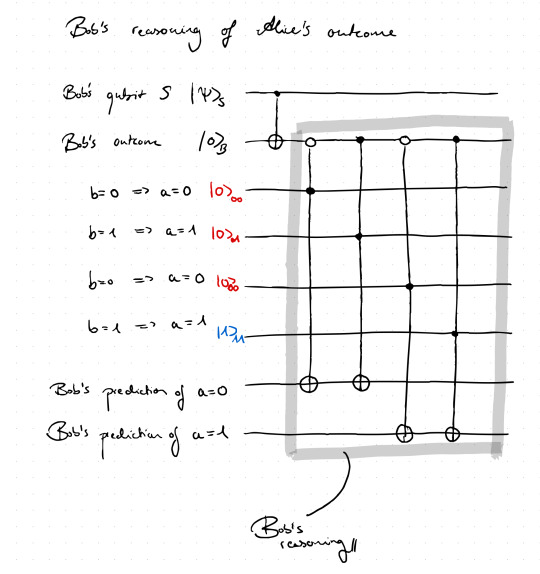
In the above circuit we added a couple of additional wires. One set represents the four possible logical inferences in this case, and the last two wires will show what Bob's prediction will be based on the initialized inferences. Let's go through this step by step:
There are four possible inferences on the measurement outcomes a and b, but only one of them is assumed to hold, namely (b = 1 -> a=1), which is why only the wire corresponding to this inference is initialized in state |1>. The other three inferences, which are assumed not to hold, are initialized in |0> and since there are control nodes from the nonlocal Toffoli-type on those wires, they will not really contribute as long as one does not change the initialization. Those Toffoli-type gates have two control nodes each as well as a NOT at the lower end. One control node is placed on Bob's memory qubit, acting dependently on the outcome b and represents the antecedent of each possible inference. If the inference of a wire assumes b=1 the corresponding Toffoli node on Bob's memory will be black, while it will be white for b=0. The second control node of each Toffoli gate is black in order to be activated according to which inference is initialized with state |1>. The consequent of those inferences is modeled by the lowest two wires. The NOT of each Toffoli is placed on the corresponding wires representing the consequent. Looking at the Toffoli for the inference b=1 -> a=1, one can see that if Bob's memory is in |1> and simultaneously the wire of the corresponding inference is initialized as |1> as well, the NOT on the lowest wire will turn the respective state to |1> (the prediction wires are initialized in |0>). Thus, Bob's prediction can be read off by the states of the prediction wires. Finally, one can also run this circuit and check its consistency - how?
Consistency Checks

In the above image we have put together all we got so far: Alice's actions from before, as well as bob's actions and his reasoning as discussed right above. The consistency of such a model can be checked by measuring the prediction wires as well as Alice's memory qubit. In this case, the only deterministic inference will show itself if Bob's prediction wire for a=1 will be |1> and this will coincide with Alice's memory being in |1>. For the other case, no inference can be done. This way one can check the consistency of the model and if the results show paradoxical outcomes one knows that something went wrong, that something in the logical reasoning / adopted interpretation of quantum theory is getting problematic. Having everything formalized as a quantum circuit will make the analysis of the issues easier.
Final Remarks
It appears to me that Quantum Circuits are not used here because one expects some computational advantage by running them on a Quantum Computer - instead they are used to neatly formalize subsystems and possible inferences of thought experiments. This way, thought experiments can be made more clear and transparent as well as it is easier to see the problem if the outcomes are not consistent. Therefore, their work shows that quantum circuits have a much broader field of application - it is not only about striving for some kind of quantum advantage for specific decision problems, instead they can also be used to formalize concepts in foundations of quantum mechanics; and this is something I have never thought about before, which is why I am so fascinated by the idea.
---
References:
[1] Nurgalieva, Mathis, del Rio, Renner - Thought experiments in a quantum computer. arXiv:2209.06236
#physics#mysteriousquantumphysics#quantum physics#studyblr#physicsblr#science#education#quantum#philosophy of science#philosophy#quantum computing
99 notes
·
View notes
Text

33 notes
·
View notes
Text
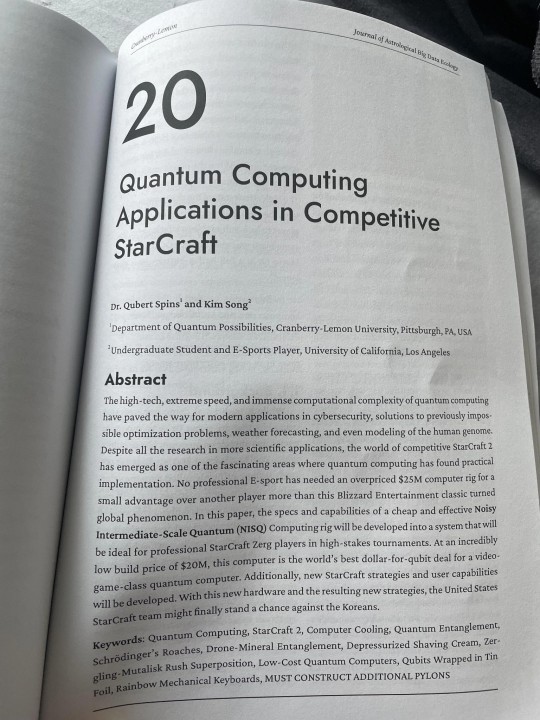
20 notes
·
View notes
Photo
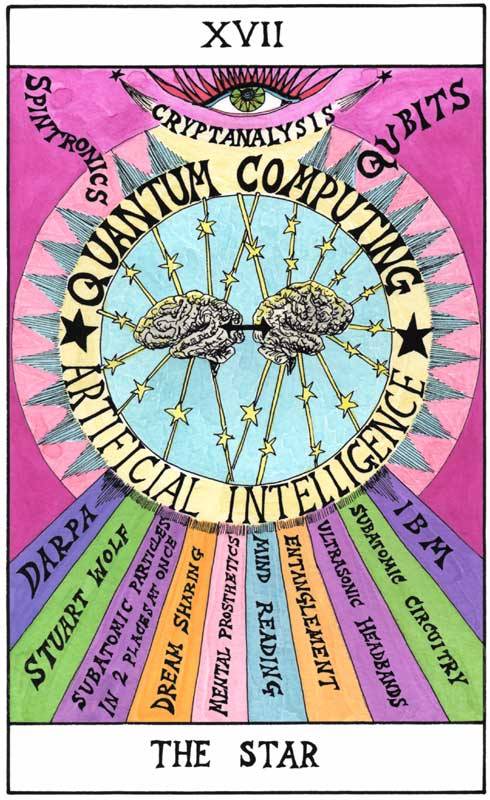
The Star. Art by Suzanne Treister, from HEXEN 2.0.
Quantum Computing - AI
25 notes
·
View notes
Text
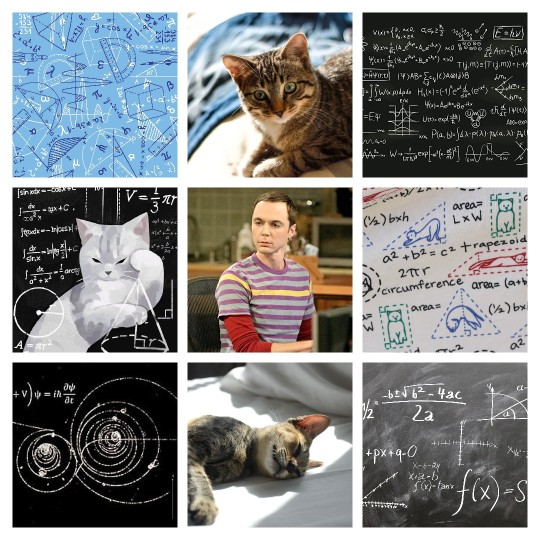
Moodboard for Sheldon Cooper (Big Bang Theory) cats/quantum computing/math themes
For an anon~ Hope you like the look!
Send an ask, we're open!
#sheldon#sheldon cooper#sheldon tbbt#tbbt#tbbt sheldon#the big bang theory#the big bang theory aesthetic#big bang theory#cat#cats#cat aesthetic#kitty#quantum computing#quantum aesthetic#math#math aesthetic
86 notes
·
View notes